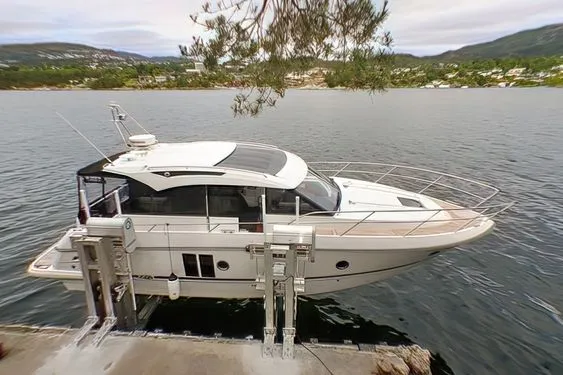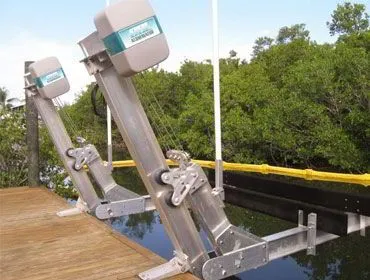Boat lift motor and gearbox systems are crucial for the longevity and maintenance of your boat. By lifting your boat out of the water when it's not in use, you protect it from water damage, corrosion, and biofouling. This guide aims to demystify boat lift motors and gearboxes, ensuring you choose and maintain the right system for your boat.
Section 1: Understanding Boat Lift Motor and Gearbox Systems
Definition and Functionality
A boat lift system primarily consists of a motor that powers a gearbox, which in turn lifts or lowers your boat. The motor provides the necessary power, while the gearbox adjusts the motor's speed and torque, making it suitable for lifting heavy loads smoothly and efficiently.
Types of Boat Lift Motors
Boat lift motors are integral components in boat lifts, playing a crucial role in safely and efficiently raising and lowering boats out of the water. There are several types of motors available, each suited to different types of boat lifts and specific user needs. Below are the primary types of boat lift motors:
Electric Motors
- AC (Alternating Current) Motors: These are the most common type of boat lift motors. They are reliable, efficient, and available in various horsepower ratings to accommodate different boat sizes and weights. AC motors require a connection to a power source, usually shore power.
- DC (Direct Current) Motors: DC motors are powered by batteries, making them ideal for locations without direct access to electrical service. They're especially useful for portable boat lifts or in areas where power outages are common.
Hydraulic Motors
Hydraulic motors use hydraulic fluid power to lift and lower the boat. They are known for their smooth operation and can handle very heavy loads, making them suitable for large boats and yachts. Hydraulic boat lifts are typically more expensive and require more maintenance than electric lifts.
Manual Motors
For smaller boat lifts, manual motors (or hand-cranked systems) can be an option. These require physical effort to operate and are best suited for light boats or situations where electrical power is not available or desired. They are the most cost-effective option but are less convenient for frequent use.
Solar-Powered Motors
Solar-powered motors are essentially DC motors equipped with solar panels. They are an eco-friendly option, reducing the dependence on grid power and allowing for the use of boat lifts in remote locations. The efficiency of solar-powered motors depends on sunlight availability and may require additional batteries for backup.
Variable Speed Motors
Variable speed motors allow for precise control over the lift speed, offering the ability to slow down or speed up depending on the situation. This type of motor provides smoother operation, which can be particularly beneficial for delicate or large boats that require careful handling.
Selection Criteria
- Power Source Availability: The choice between AC, DC, and solar-powered motors depends on the availability of power sources at the lift site.
- Boat Size and Weight: Heavier boats require more powerful motors with higher torque, possibly leaning towards hydraulic systems for very large vessels.
- Usage Frequency: For lifts used daily, electric or hydraulic motors offer the best convenience. For occasional use, manual or solar-powered options might suffice.
- Budget and Maintenance: Electric and manual motors generally have lower upfront costs and maintenance requirements compared to hydraulic systems.
- Environmental Considerations: Solar-powered lifts are ideal for those looking to minimize their environmental impact.
Understanding these types of boat lift motors and considering your specific needs and conditions will help you make the best choice for your boat lifting requirements.
Types of Gearboxes
Gearboxes are critical components in various mechanical systems, including boat lifts, where they are used to increase torque while reducing speed from the motor to the lift mechanism. The type of gearbox chosen can significantly affect the performance, efficiency, and longevity of the system. Here are the primary types of gearboxes commonly used in different applications, including boat lifts:
Spur Gearboxes
- Characteristics: Consist of straight teeth and are mounted on parallel shafts. They are known for their simplicity and high efficiency.
- Applications: Common in applications that require high power transmission at medium to high speeds, such as conveyors and pumps. Due to their noise levels, they're less common in low-speed, high-torque applications like boat lifts unless noise is not a concern.
Helical Gearboxes
- Characteristics: Feature angled teeth, resulting in a more gradual engagement of the gears. This design offers smoother and quieter operation than spur gears.
- Applications: Widely used in both industrial applications and consumer products where noise reduction is important. Suitable for boat lifts, particularly in residential areas or marinas where noise sensitivity might be an issue.
Bevel Gearboxes
- Characteristics: Equipped with conically shaped teeth, allowing them to operate at angles typically 90 degrees but can vary. They are used to change the axis of rotation.
- Applications: Ideal for applications requiring torque to be transmitted between non-parallel shafts, such as in differential drives for vehicles. Less common in boat lifts unless there's a need for such angular transmission.
Worm Gearboxes
- Characteristics: Comprise a worm (screw) that meshes with a worm gear (wheel). This setup allows for high reduction ratios, low noise, and smooth operation, with a built-in locking mechanism that can prevent backdriving.
- Applications: Particularly suited for boat lifts due to their ability to handle heavy loads with great precision and their inherent braking capability, ensuring the boat remains securely lifted without backdriving.
Planetary Gearboxes
- Characteristics: Consist of a central ‘sun' gear surrounded by multiple ‘planet' gears, all contained within an outer ‘ring' gear. They offer high efficiency, compact size, and excellent power distribution across multiple gears.
- Applications: Used in applications requiring high torque density, reliability, and compactness, such as in aerospace, automotive, and heavy machinery. In boat lifts, they might be used for their strength and efficiency in a compact form factor.
Hypoid Gearboxes
- Characteristics: Similar to bevel gears but with axes that do not intersect, allowing for larger contact surfaces and greater efficiency. They combine the benefits of worm and bevel gears.
- Applications: Common in automotive applications for differential gears. Their use in boat lifts would be more specialized, likely in designs requiring efficient power transmission at skewed angles.
Section 2: Selecting the Right Boat Lift Motor and Gearbox
Selecting the right boat lift motor and gearbox involves several key considerations to ensure optimal performance, reliability, and longevity of your boat lift system. Here's a comprehensive guide to help you make an informed choice:
Understanding Your Boat Lift System
- Lift Capacity: Determine the total weight of your boat, including fuel, gear, and any other onboard items. Your boat lift motor and gearbox must be rated to handle this weight comfortably.
- Lift Type: Know the type of your boat lift (e.g., cradle, sling, cantilever, vertical, or hydraulic). Different lift types may require specific motor and gearbox setups.
- Power Supply: Check the availability and type of power supply (AC or DC) at the installation site. AC motors are common, but DC motors may be required if the electrical supply is not readily available.
Selecting the Motor
- Horsepower (HP): The motor's HP should match the lift capacity. A higher HP motor can lift the boat faster but will use more power. Typically, a motor with 1 HP for every 4,000 lbs of boat weight is sufficient, but consult manufacturer recommendations.
- Voltage and Phase: Ensure the motor's voltage (e.g., 120V, 240V) matches your power source. Most residential locations use single-phase power, while three-phase might be available in commercial or industrial settings.
Selecting the Gearbox
- Gear Ratio: This determines the speed and torque of the lift. A higher gear ratio increases torque but reduces speed, suitable for heavy boats. The ideal gear ratio depends on your lifting speed preference and the weight of the boat.
- Material and Construction: Look for corrosion-resistant materials, especially in saltwater environments. Stainless steel components, though more expensive, offer greater durability and resistance to corrosion.
- Maintenance and Warranty: Consider the maintenance requirements and the warranty offered by the manufacturer. A longer warranty and accessible customer service can save time and money in the long run.
Environmental and Operational Considerations
- Saltwater vs. Freshwater: For saltwater environments, ensure both the motor and gearbox are designed to resist corrosion.
- Weather Conditions: If your boat lift is exposed to extreme weather, consider weatherproof or waterproof rated motors and gearboxes.
- Noise Levels: In residential areas, a quieter motor and gearbox might be preferable. Helical gearboxes, for example, operate more quietly than spur or worm gearboxes.
Final Checklist
- Verify lift capacity requirements.
- Match the motor and gearbox to the type of power supply available.
- Choose components based on environmental conditions (saltwater or freshwater).
- Ensure the system meets your operational needs, including speed, noise, and maintenance preferences.
By carefully considering these factors, you can select a boat lift motor and gearbox that not only meets your specific needs but also ensures a reliable and efficient boat lifting experience for years to come. If you're uncertain, consulting with a professional or a manufacturer can provide personalized advice tailored to your situation.
Section 3: Installation Tips and Tricks
Section 4: Enhancing Your Boat Lift System
Accessories and Upgrades Consider remote controls for ease of use, solar panels for DC motors to reduce energy costs, and protective covers to extend the system's life.
Innovations in Boat Lift Technology Stay updated on the latest in boat lift technology, such as Bluetooth connectivity for remote monitoring and control, or advancements in materials that offer better durability and efficiency.
Conclusion Choosing the right boat lift motor and gearbox is vital for protecting your investment and enjoying your time on the water. With the right system, regular maintenance, and potential upgrades, your boat lift can provide years of reliable service.
FAQs This section could address the most common questions you might have about boat lift motor and gearbox systems, such as how to choose the right size, the benefits of AC vs. DC motors, and how often to perform maintenance.

